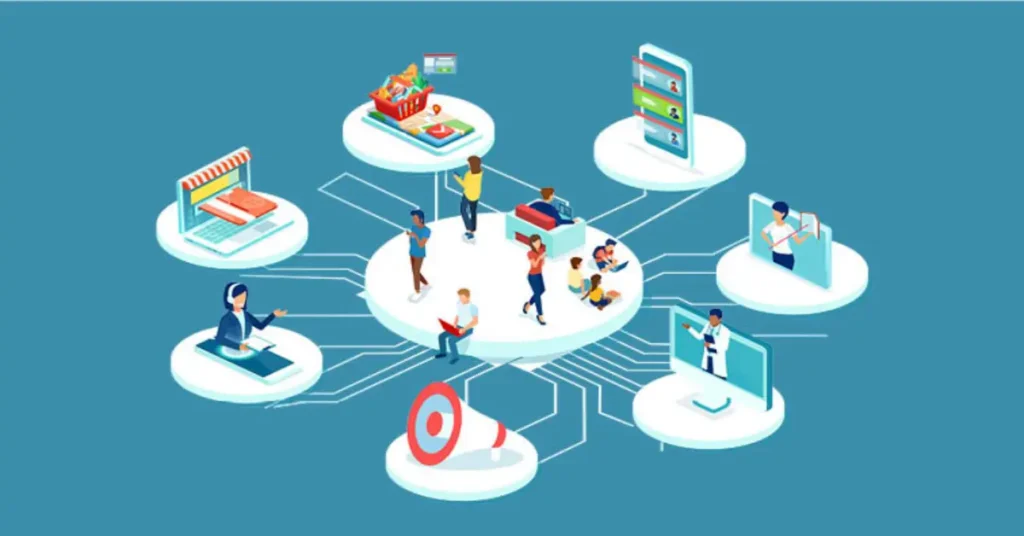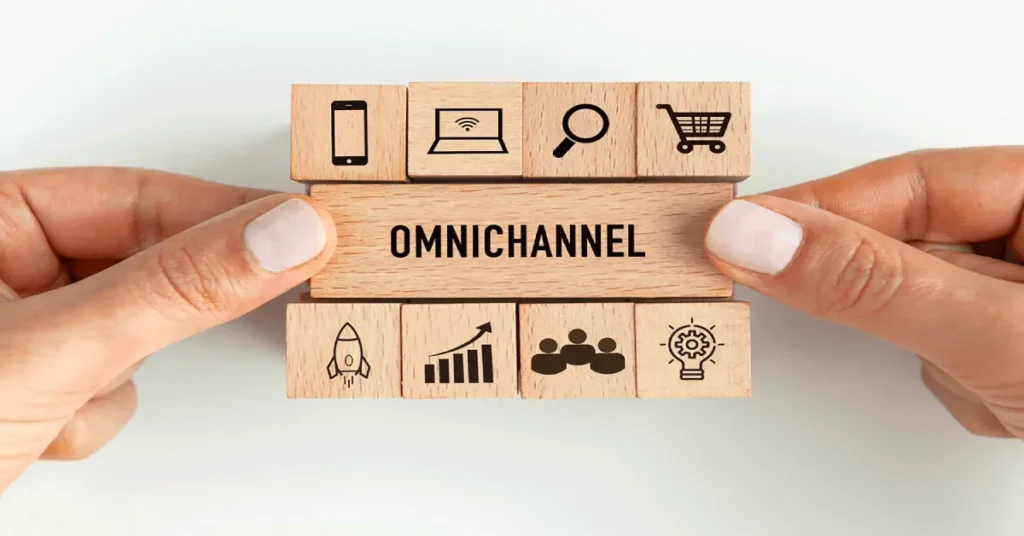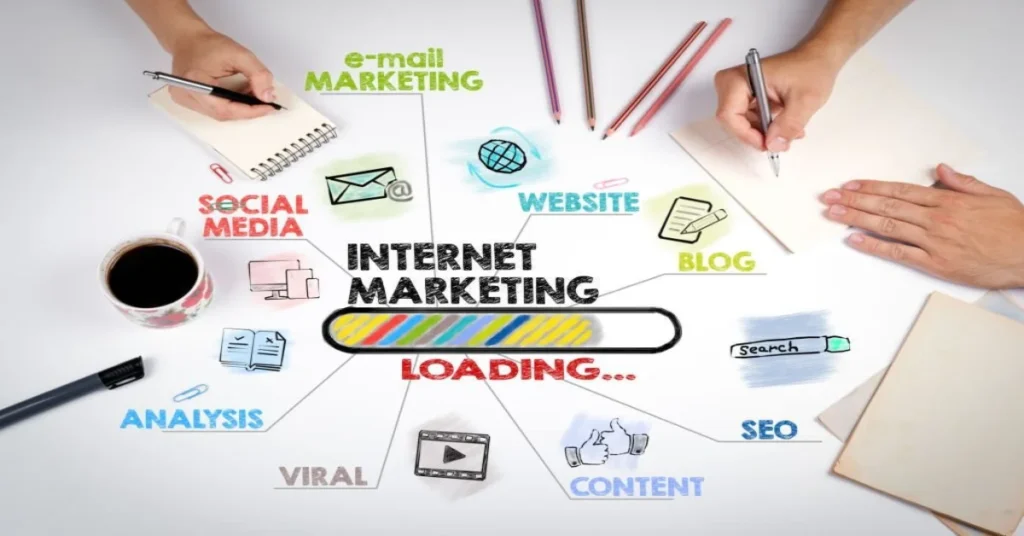Introduction
Navigating the modern marketplace means understanding your customers wherever they are. This is where an omnichannel marketing platform becomes your most valuable tool. Imagine every interaction a customer has with your brand—from browsing your website on their phone to visiting your physical store, opening an email, or chatting with support—all connecting perfectly. That is the power of omnichannel marketing.
The Evolution of Customer Engagement: More Than Just Many Channels

Years ago, businesses focused on “multichannel” marketing. This meant they used many different ways to talk to customers: email, social media, a website, maybe even a physical store. But these channels often worked in silos. A customer’s experience on your website might not connect to their experience in your store. Their email history might not inform a conversation with customer service.
What is Omnichannel Marketing? Thinking Customer-First

Omnichannel marketing changes that. It puts the customer at the center, creating a truly unified experience across all contact points. Think of it like this:
- Multichannel: You offer many doors into your house, but each room is separate. You cannot walk from the kitchen to the living room without going outside and re-entering a different door.
- Omnichannel: You offer many doors, but all rooms connect seamlessly. You can move from the kitchen to the living room, then to the dining room, all inside the same house.
The goal is consistency. Whether a customer starts on your app, switches to your website, or calls your support line, their journey feels like one continuous conversation. According to UniformMarket, 73% of retail shoppers are omnichannel shoppers in 2025. They expect this seamless flow.
Why Omnichannel is Crucial in Today’s Market
Customers today expect more. They want personal, consistent interactions. A recent Statista report reveals that 83% of consumers believe a personalized experience enhances brand loyalty. If a customer receives a text about a product they just bought, that is a frustrating disconnect. An omnichannel approach helps prevent this.
It is about boosting customer loyalty and keeping them longer. Companies with strong omnichannel engagement strategies retain an average of 89% of their customers, whereas those with weaker strategies retain only about 33%. That is a massive difference. Shoppers who use both online and in-store channels are worth 30% more to a business over their lifetime compared to those who shop using only one channel.
The Role of Omnichannel Marketing Platforms
This is where the technology steps in. An omnichannel marketing platform is the brain that connects all these dots. It brings all your customer data into one place. It helps you automate messages and ensures every team member sees the complete picture of each customer. This means personal messages, faster service, and happier customers.
According to the UniformMarket Blog, Omnichannel Statistics For Marketers reveals that Omnichannel shopping is dominant, with 73% of consumers using multiple channels in their purchase journey, and 83% researching online before in-store visits. This contrasts sharply with limited single-channel shopping, showing a clear consumer preference for integrated experiences.
Businesses adopting omnichannel strategies see significant benefits, including 89% customer retention (compared to 33% for non-omnichannel), 9.5% higher annual revenue growth, 250% higher purchase rates, and a 13% increase in average order value. These strategies also lead to 80% more in-store visits and higher in-store spending.
Key omnichannel features driving success include click-and-collect (BOPIS/curbside pickup), which is highly popular and often prompts additional in-store purchases. Personalized experiences and mobile commerce are crucial for brand loyalty and sales.
The future of retail embraces unified commerce, integrating all sales, fulfillment, and service processes onto a single platform, which reduces costs and improves customer experience. Real-time in-store stock availability is also an increasingly important feature for conversion.
Consumers expect a consistent and seamless experience across all touchpoints, from online browsing to in-store visits. This includes essential expectations like fast, convenient service, free shipping, and easy returns.
Essential Features of a Leading Omnichannel Marketing Platform

Choosing the right platform means understanding what makes it powerful. Here are the core capabilities you should look for:
Unified Customer Data Platform (CDP) and Profile Management
A CDP is the heart of an omnichannel platform. It collects all customer interactions from every source: your website, mobile app, email campaigns, social media, and even in-store purchases and customer service calls.
- Key Benefit: It creates a “single customer view.” Imagine knowing everything about a customer, from their first website visit to their last purchase and every support ticket. This holistic profile helps you understand their needs and preferences deeply.
- Real-time Data: This data updates constantly. If a customer adds an item to their cart online, the system knows it immediately, allowing for a timely follow-up email.
Advanced Segmentation and Personalization
With all that data, you can divide your customers into groups based on their behavior, interests, and demographics. This is called segmentation.
- Dynamic Groups: You can create groups like “customers who bought running shoes last month” or “people who browsed hiking gear but did not buy.”
- Hyper-personalization: The platform uses AI and machine learning to predict what a customer might want next. It suggests products, tailors website content, or sends truly individualized offers. Bloomreach notes that AI refines personalization, predicting customer needs and tailoring marketing messages.
Multi-Channel Orchestration and Automation
This is where your marketing actions come alive across all channels.
- Cross-Channel Campaigns: You can design a customer journey that starts with a social media ad, leads to an email, then a text message, and maybe even a personalized website experience.
- Visual Journey Builders: Many platforms offer drag-and-drop tools to map out these complex paths. If a customer opens an email, send them a text. If they do not, try a different email.
- A/B Testing: You can test different messages or channels to see what works best for different customer segments.
Comprehensive Analytics and Reporting
You need to know if your efforts are working. A good omnichannel platform provides deep insights.
- Attribution Modeling: This helps you understand which touchpoints along the customer journey contributed to a sale. Was it the first ad they saw, the email they opened, or the in-store visit?
- Real-time Dashboards: See how your campaigns perform right now.
- ROI Tracking: Crucially, it helps you connect marketing activities to actual business results.
Integration Capabilities (CRM, ERP, E-commerce, Customer Service)
A standalone platform is not enough. It must connect with your existing business systems.
- Seamless Connections: Does it easily integrate with your CRM (Customer Relationship Management) system? Your e-commerce platform, like Shopify or BigCommerce? Your customer service software is like Zendesk?
- Open APIs: This means it offers tools for custom connections if you have unique systems.
Scalability and Flexibility
Your business will grow, and your platform should grow with you.
- Adaptable: A good platform serves small businesses needing simple tools and large enterprises requiring complex, high-volume solutions.
- Customization: You should be able to adjust it to fit your specific industry and operational needs.
When you’re ready to power up your growth even further, remember that understanding your customers across all their interactions is key. We just explored how an omnichannel marketing platform can connect those dots, but to build the foundational strategies for reaching those customers, you might want to visit my detailed blog post on digital marketing for small business owners. It offers practical advice to help you establish a strong online presence and attract your ideal audience.
Navigating the Omnichannel Platform Landscape: Your Smart Choices

Choosing an omnichannel marketing platform feels like a big decision. Here is how to approach it thoughtfully.
Identifying Your Business Needs and Goals
Before you even look at platforms, ask yourself:
- What exactly do I want to achieve? More leads? Happier customers? Higher sales?
- What technology do I use now? How will a new platform fit in?
- What is my budget, and what resources do I have for implementation and ongoing management?
A Deeper Look at Features for Different Business Needs
Many articles list features, but let’s consider how specific features help your kind of business.
- For E-commerce and Retailers: If you sell products online or in stores, you need features that tackle challenges like abandoned carts. Look for platforms that excel at automated reminders when someone leaves items in their online basket. Can they suggest related products based on past purchases? Do they easily connect with your point-of-sale (POS) system for loyalty programs or in-store pickup options? Omnisend and Klaviyo are often highlighted for their e-commerce focus.
- For B2B (Business-to-Business) & Complex Sales Cycles: If your sales involve longer relationships and multiple decision-makers, you need powerful lead nurturing and account-based marketing tools. Can the platform automate personalized emails and content for each stage of a lengthy sales process? How well does it integrate with your CRM to ensure sales teams have every customer interaction at their fingertips? HubSpot and Salesforce Marketing Cloud are often strong contenders here.
- For Enhancing Customer Service and Engagement: Sometimes, the platform’s primary goal is customer happiness. Think about unified inboxes where customer service agents see all interactions, whether a customer contacted them via email, chat, or social media. Can chatbots handle common questions, freeing up human agents for complex issues? How easily can support teams hand off issues to marketing or sales, ensuring the customer’s experience remains seamless? Zendesk and Intercom offer robust customer service integrations.
- For Small & Medium Businesses (SMBs) vs. Enterprises: Ease of use is key for SMBs, often with smaller teams. How quickly can you set it up? Does it require extensive coding or IT support? Enterprise solutions often come with more complex features and deeper customization, but demand more resources. HubSpot and ActiveCampaign are often praised for SMB usability, while Adobe Experience Cloud is a strong enterprise player.
Understanding Omnichannel Platform Pricing Models
When exploring platforms, pricing can seem confusing. Beyond the monthly fee, let’s explore what lies beneath the surface.
- Common Pricing Structures: Many platforms charge based on the number of contacts you have, the volume of emails or messages you send, or the specific features you unlock. Some offer “per-user” pricing.
- Beyond the Sticker Price: It’s important to ask about potential extra costs. Are there setup fees? Do advanced integrations cost more? What about premium support? A “free plan” can be a great starting point, but understand its limitations.
- Thinking About Value: Instead of just the lowest price, consider the platform’s return on investment. A slightly more expensive platform that brings in more sales or saves significant staff time could be a better value. For example, EngageBay offers a tiered structure starting at $14.99/month, while HubSpot’s enterprise plan can reach $3,600/month. Each offers different capabilities for different needs.
Unbiased Reviews and User Perspectives
How do you find honest opinions about these platforms? While many articles list platforms, it can be hard to find truly neutral evaluations.
- Crowd-Sourced Reviews: Websites like G2, Capterra, and TrustRadius collect thousands of user reviews. I always look there first. They offer ratings on “ease of use,” “quality of support,” and “likelihood to recommend.”
- Look for Your Peers: Search for reviews from businesses similar to yours in size and industry. An e-commerce brand’s needs differ from a B2B service provider.
- Specific Feedback: Pay attention to comments on integration difficulties, the learning curve, or the responsiveness of customer support. This kind of specific feedback often provides the most helpful clues.
The Path to Success: Implementation & Proving Your Investment

Getting an omnichannel platform up and running is more than just turning on software. It involves careful planning and measuring results.
Overcoming Common Implementation Challenges
Even the best platforms can present hurdles. Here’s how to anticipate and manage them.
- Connecting Your Data Dots: Your customer data might live in many places: your old CRM, your website, your email marketing tool. Bringing it all together into a single, clean database within the new platform takes effort. Think of it as spring cleaning for your data. You might need to merge customer records or resolve duplicate entries.
- Getting Everyone on Board: Marketing, sales, customer service, and IT all need to work together. They must understand how the new system benefits them. Training is key. Imagine a sales team suddenly seeing a customer’s entire web browsing history during a call. That is powerful, but they need to know how to use it.
- Knowing What to Measure: Beyond basic sales, how will you know your omnichannel efforts are paying off? Focus on metrics like “customer lifetime value” (how much a customer spends with you over time), “churn rate” (how many customers leave), or “cross-channel conversion rates” (how many people buy after interacting with multiple channels).
- Technical Know-how and Support: Integrating a new platform can be complex. Sometimes, you need dedicated IT help or a specialized partner. Planning for these resources upfront helps avoid surprises.
Calculating the Return on Investment (ROI) for Your Omnichannel Platform
Proving your platform’s worth in dollars and cents is essential.
- The Basic Idea: ROI helps you see if the money you put into the platform is bringing in more money or saving costs. The simple formula is: ROI (Total Cost of Platform/Total Revenue Attributed to Omnichannel- Total Cost of Platform)×100
- What to Count as Revenue:
- Direct Sales: Increased purchases from personalized campaigns.
- Reduced Abandonment: Fewer lost sales from things like abandoned cart reminders.
- Higher Lifetime Value: Customers stay longer and spend more.
- What to Count as Cost Savings:
- Operational Efficiency: Automating tasks can save staff time.
- Reduced Support Costs: More consistent experiences mean fewer customer complaints.
- Better Resource Allocation: Knowing what works means smarter spending on marketing.
- Example: A clothing retailer spends $10,000 on a new platform and related efforts. They see a $55,000 increase in sales across their online store and physical locations. ROI = ($ 10,000- $ 55,000) × 100 = 450%. This means that for every dollar spent, they earned $4.50 in profit. The V-Count Blog provides more details on calculating omnichannel ROI.
Best Practices for Successful Omnichannel Adoption
- Start Small, Learn, Then Grow: You do not need to do everything at once. Pick a few key customer journeys, test your approach, and then expand.
- Map Your Customer’s Journey: Understand every step a customer takes, from discovering your brand to becoming a loyal advocate. This helps you identify where an omnichannel approach can have the biggest impact.
- Always Be Optimizing: Data from your platform helps you see what’s working and what’s not. Continuously adjust your campaigns and customer journeys.
- Think Mobile First: Most customers use their phones. Ensure every experience on mobile is smooth and effective.
The Future of Omnichannel: What’s Next?

The world of customer engagement never stands still. Here are some interesting directions omnichannel platforms are heading.
AI & Machine Learning: Beyond Basic Personalization
We’re already seeing AI help with personal recommendations. But what if it could do more?
- Predictive Engagement: Imagine a platform that predicts a customer is about to stop buying from you. It could trigger a special offer or a personalized message to keep them.
- AI for Content Creation: Generative AI tools could help create marketing messages or even entire campaigns, freeing up your team to focus on strategy.
- Smarter Support: AI-powered chatbots will become more human-like, handling complex customer queries and seamlessly handing off to human agents when needed. Bloomreach talks about agentic AI making marketing more dynamic.
Hyper-Personalization: One-to-One at Scale
It is about reaching an individual customer with the right message at the exact right moment.
- Real-time Context: Platforms will use real-time data to personalize experiences based on a customer’s immediate actions, location, or even their mood.
- New Touchpoints: How will virtual reality shopping experiences or voice assistants integrate into the omnichannel journey? These new ways of interacting offer fascinating possibilities.
Data Privacy and Ethical AI: Building Trust
As platforms collect more data, privacy becomes even more important.
- Stronger Protections: Platforms will need to adapt to evolving data privacy laws like those in the US (e.g., CCPA and potential new federal regulations).
- Transparency: Brands will need to be very clear with customers about how their data is used. This builds trust and encourages customers to share more.
- Fair AI: Ensuring AI models are not biased and use data ethically will be crucial.
The Convergence of Marketing and Advertising Technology
The lines between managing your existing customers and attracting new ones are blurring.
- Unified View: Expect platforms to combine tools for managing owned channels (email, website) with paid advertising (social media ads, search ads).
- Smarter Ad Spending: This means your advertising dollars can be spent more wisely, targeting people based on their full customer profile.
Conclusion: Finding Your Best Omnichannel Partner
An omnichannel marketing platform is not just another piece of software; it is a strategic asset. It helps you build stronger, more meaningful relationships with your customers by ensuring every interaction is connected, personalized, and consistent.
By embracing an omnichannel approach, businesses can unlock significant growth, improve customer loyalty, and stand out in a crowded market. Take the time to understand your needs, explore the options, and choose a platform that helps you build a truly customer-centric future.





